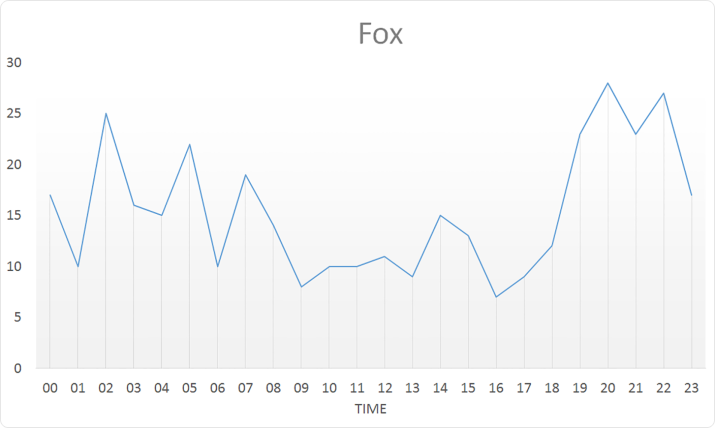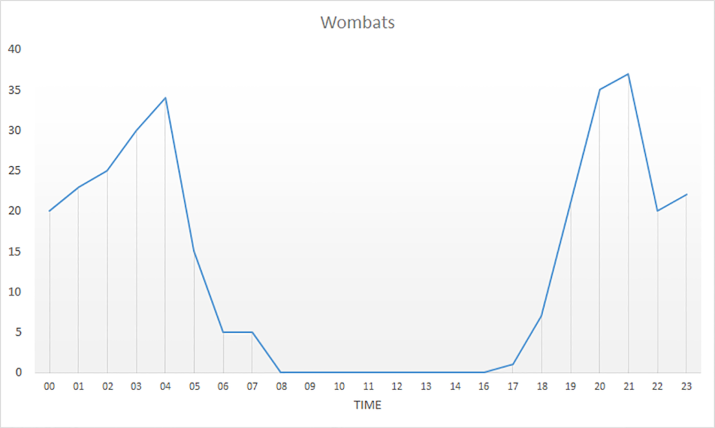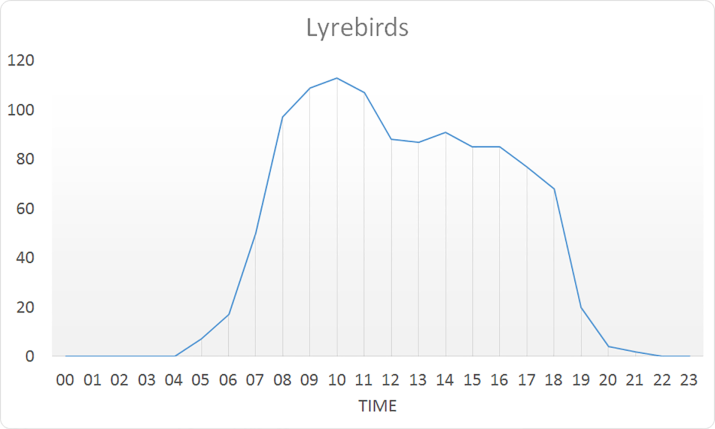A recent post reporting on the results of our camera trap monitoring program for 2013, identified a trend with Swamp Wallabies where numbers photographed by across the park by camera traps dropped very sharply after July. We have no real explanation for this, but as we gather further data, it will be interested to see large annual fluctuations in the Wallaby count continues.
We had an inquiry as to whether it was more common to record Swamp Wallabies in daylight or during the night-time, which is an interesting question and one which is easy to work out from our database. So after crunching some numbers here are some answers, not just for Swamp Wallabies, but for all our commonly recorded species.
Swamp Wallabies
Swamp Wallaby triggers are fairly regular at any time of day or night, they do seem to slow down as you might predict in the middle of the day, but then fire up to have their peak numbers in the early evening.
Wombats
Although it is not particularly uncommon to see Wombats out during the day sometimes, perhaps surprisingly we have never had one trigger a camera between 8am to 4pm. They seem to have peak activity in the evening and another peak around 4am.
Long-nosed Bandicoots
It’s no surprise that these Bandicoots are rarely seen, although we get fairly regular photos of them, they seem to have a definite peak of activity between 2am and 4am.
Foxes
 The graph shows here that there is never any time of day for animals to be complacent. Foxes can be active at any time of day, seems like they are marginally more common at night. Also have data on Feral Cats, they too can be around at all hours, but seem less likely than a Fox to be around in daylight.
The graph shows here that there is never any time of day for animals to be complacent. Foxes can be active at any time of day, seems like they are marginally more common at night. Also have data on Feral Cats, they too can be around at all hours, but seem less likely than a Fox to be around in daylight.
Lyrebirds
Lyrebirds in Tarra-Bulga obviously need to make the most of the daylight hours. It seems there is a slightly greater chance they will be snapped by a camera in the morning, but overall any time of the day is good for them.





Interesting looking data. What database are you using? One of your own or Camera Base (http://www.atrium-biodiversity.org/tools/camerabase/)?
Just a simple Access database I made up myself, had never heard of Camera Base until now. Might have to check it out, although perhaps with reluctance given we have now logged over 5000 records into our system.
If you’re looking at databases, there’s another one here (http://myrimba.org/2012/01/05/toolbox_update_5/). Both this and Camera Base are MS Access derived, so transferring data should be easy (if you decided to take the plunge).
Do you use either one? looks like they have some good features, but I am reasonably happy with my own method. Usually find personally that it is better to build my own databases, because other peoples rarely exactly fit your needs. Also have a better idea of how the table fit together when it is something I have built my self. It would be handy to see the photos live on the database, but I am starting to have too many photos to fit on the computer so feature would be confused by me having to archive files.
Thank you for mentioning them, very interesting to see the data they are capturing and given me a few ideas for other things we might like to record.
I would have replied to your last comment but the reply button isn’t showing. I don’t use either database at the moment because we don’t get too many records here (Brisbane Ranges). I may look at Camera Base because it can run as a stand alone without the need to have Access installed.
As far as data recording for camera traps, there’s a recent paper proposing standardised principles for reporting camera trap data (
“Recommended guiding principles for reporting on camera trapping”:
http://link.springer.com/article/10.1007/s10531-014-0712-8).
This is an interesting way to observe the behaviour of wildlife. Thanks for posting the information. We have Swamp Wallabies here, and we mainly see them early in the mornings and at twilight. Some exceptions when it is raining for some reason, also when it is hot, they come out to drink from the dam. Lisa
Do you go outside at night with a torch or a spotlight and see what is around. Do that at home and seem to have less around than I used to, but getting Sugar Gliders chasing Eucalypt blossoms at the moment which is cool.